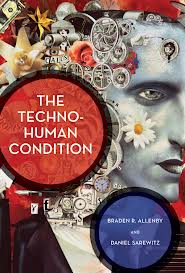
This is from The Techno-Human Condition by Braden Allenby and Daniel Sarewitz:
Until now, some are saying, our application of technology to enhancing our capabilities was largely external: we constructed tools that we could wield to increase our capacity to do things, but as wielders we were essentially fixed in our capabilities. We controlled our external environment, not our internal selves. Even when we did things to enhance our inner capabilities, we did them with external interventions—eyeglasses, education, and the like. Now, we are told, with powerful new genetic technologies on the horizon, with the increasing fusion of human and machine intelligence, and with neuropharmaceuticals, artificial body parts, and stem cell therapies, we are beginning the business of transforming ourselves from the inside out, of exerting explicit and conscious control over our existing selves and our evolving selves in ways that create new opportunities, new challenges, and new ways of thinking about who we are and where we are going. The very notion of what it means to be human seems to be in play. For some people this is a thrilling and wonderful prospect indeed, while others are filled with dread and despair.
Let us differentiate between two separate dialogs about transhumanism. One involves the ways in which living humans use technologies to change themselves, for example through replacement of worn-out knees and hips, or enhancement of cognitive function through pharmaceuticals ….The second dialog positions transhumanism as a cultural construct that considers the relations between humanness and social and technological change. Many people are excitedly talking and writing about the prospects for the technological enhancement of human brains and bodies and a transition to new versions of humanness. The most avid and optimistic of these people call themselves transhumanists. The meaning of “transhumanism” sounds obvious—“between states of humanness”—yet is remarkably difficult to specify. A significant part of the ambiguity arises from one’s notions about what it means to be human. This, of course, is contentious cultural territory; after all, without agreement on the meaning of humanness one cannot specify when the technology-enabled leap to transhumanism occurs.
We don’t like the concept of the transhuman. I’m not sure if its the term or the concept. I suspect it’s both. Either way, we need to get over the idea that machines will do bits of us better than we can or in ways that our bodies no longer can. We have a hard time seeing assistive technology beyond the shallow context of 20th century science fiction. Ultimately our repulsion of the man-machine reflects a level of hypocrisy and arrogance. We celebrate the purity of our humanness but cling desperately to the technology that keeps us going.
Of course if a machine can replace something that we do, perhaps what we did was never that human to begin with.
Amazon links are affiliate links.